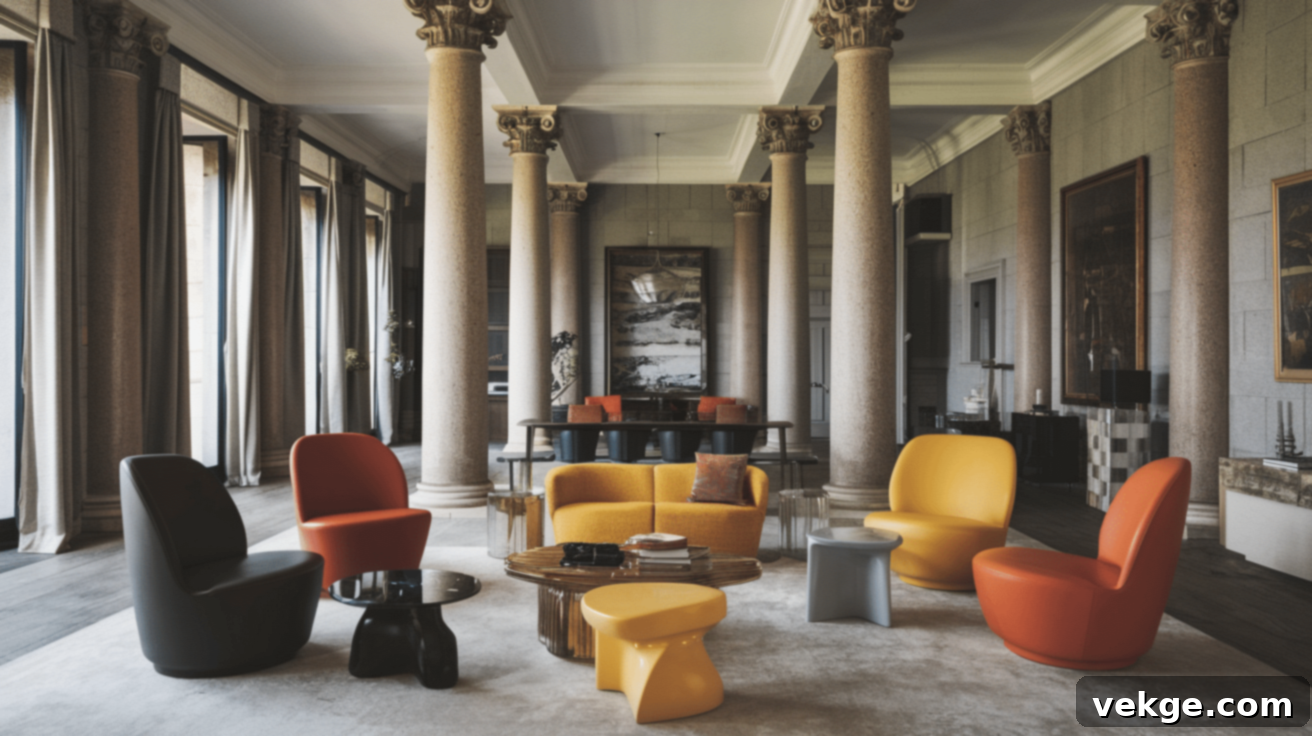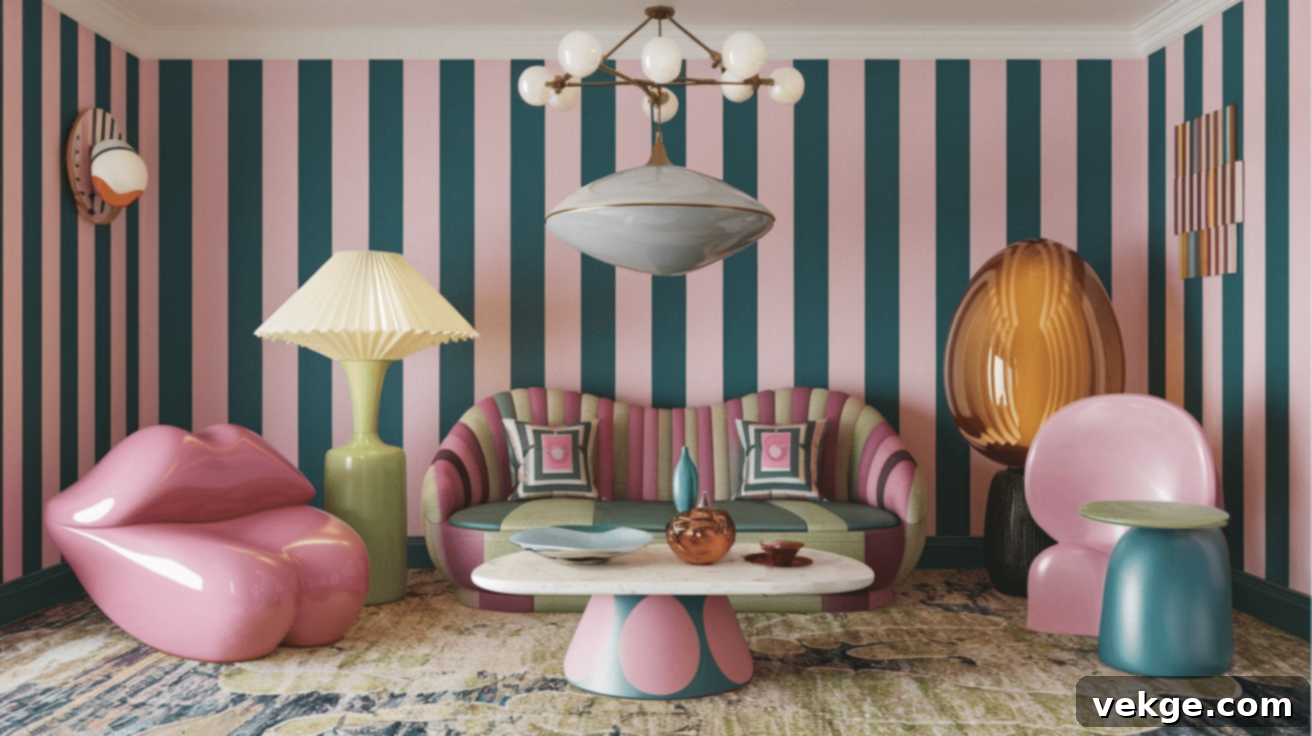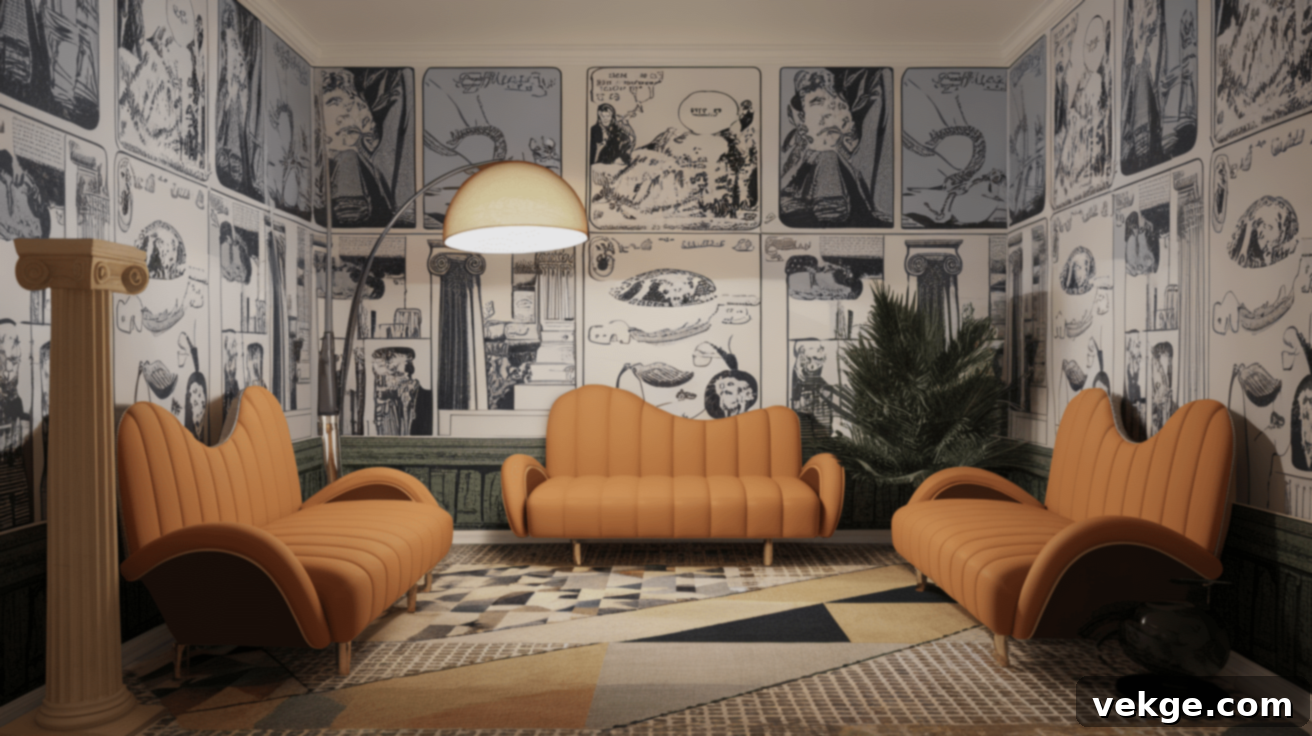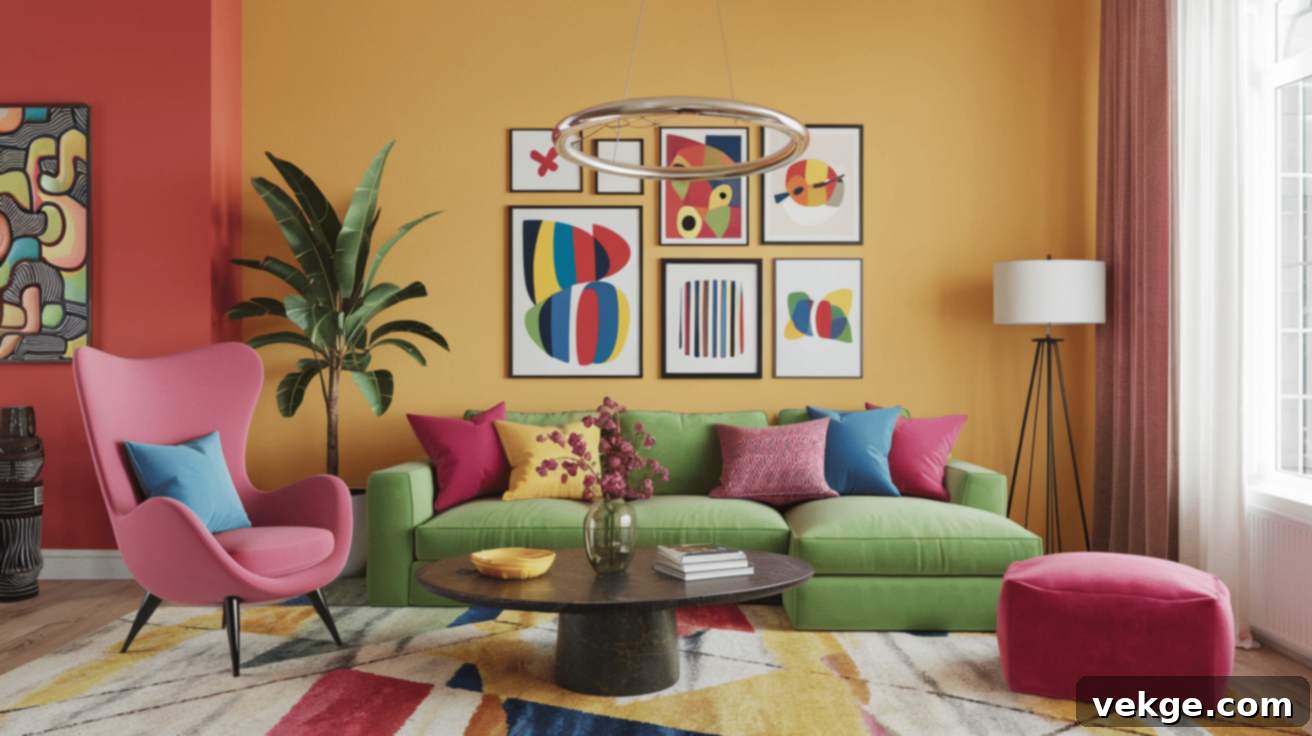Embrace Boldness: Your Ultimate Guide to Postmodern Interior Design
“Rules are made to be broken.” This simple yet powerful idea sits at the very heart of postmodern design, a revolutionary style that fundamentally turns traditional home aesthetics upside down. If you’re tired of predictable, minimalist looks and yearn for a living space that truly reflects your unique personality, then postmodern interior design offers an exciting and liberating path forward. It’s a vibrant movement that champions individuality, playfulness, and a clever subversion of conventional norms, transforming homes into dynamic, expressive works of art.
Are you ready to move beyond the expected and infuse your home with an undeniable sense of character and fun? Postmodern design isn’t just about decorating; it’s about making a statement, inviting conversation, and creating an environment that sparks joy and surprise. This comprehensive guide will explore how breaking from normal design rules can create spaces that feel fresh, exciting, and deeply personal. We’ll delve into its origins, define its key elements, and provide practical advice on how you can introduce this captivating style into your own home, making a big impact with even small, thoughtful changes.
What is Postmodern Interior Design? Defining the Rebellious Aesthetic
Postmodern interior design emerged in the 1970s and 1980s as a direct and often provocative response to the stark simplicity and functionalism of modern design. Think of it as the artistic “rebellious kid” who refuses to follow the strict, clean lines and neutral palettes of its predecessor. Where modernism sought order, clarity, and the mantra “less is more,” postmodernism declared, “more is more,” embracing complexity, contradiction, and often, a hearty dose of humor.
This dynamic style delights in mixing diverse ideas, challenging the notion that everything must match perfectly. Instead, it thrives on playful juxtapositions and unexpected combinations. You might encounter a room where vibrant, almost clashing colors dominate, or where furniture boasts bizarre, sculptural shapes that defy traditional ergonomics. Imagine a zigzag-patterned armchair casually placed beside a sleek, round glass table, or walls painted in electric purple adorned with bright yellow or teal furniture. The core principle? To mix materials, patterns, and forms that don’t traditionally “go together,” creating a deliberate visual tension that is both stimulating and uniquely appealing.
Characteristic postmodern spaces often feature:
- Bold, Bright Colors: A dramatic departure from neutral tones, embracing palettes that are often primary, secondary, or even neon, used in surprising combinations.
- Furniture with Odd or Sculptural Shapes: Pieces that look more like art than conventional seating or storage, featuring curves, angles, and abstract forms.
- Patterns That Clash on Purpose: Geometric patterns, abstract motifs, or even Pop Art-inspired graphics that create a vibrant, sometimes chaotic, but always engaging visual texture.
- A Mix of Diverse Materials: Unconventional pairings like sleek metal with rough concrete, colourful plastic with luxurious velvet, or glass with traditional wood.
- Items Serving as Both Art and Furniture: The blurring of lines between functional objects and decorative sculptures, where a chair isn’t just for sitting but also a statement piece.
What truly sets postmodern design apart is its inherent freedom – it liberates you from the “everything must match” rule. It encourages you to curate a space filled with items you genuinely love, even if they seem random or disparate. The result is a home that vibrantly expresses your personality, often eliciting smiles and intriguing conversations from anyone who enters. If your goal is for your home to feel more playful, less serious, and profoundly reflective of your individuality, postmodern design could be your perfect match!
Key Elements of Postmodernism: Pillars of Playful Rebellion
Eclectic Style: A Symphony of Juxtaposition

At the heart of postmodern design lies an unabashed love for eclecticism. This means purposefully blending styles, eras, and cultural influences that would traditionally be considered incompatible. Imagine classical Greek columns reimagined in bright plastic, juxtaposed with sleek, ultra-modern glass tables, or a luxurious antique chaise lounge sitting comfortably next to a set of simple, vibrant plastic chairs. The objective is not harmony in the conventional sense, but a deliberate visual dialogue that tells a compelling story.
This eclectic approach empowers you to create spaces that are profoundly personal and utterly unique. Your home can become a curated gallery of your life’s journey, featuring furniture from different historical periods, design movements, and global inspirations, all harmoniously (or deliberately disharmoniously) coexisting within a single room. It’s about celebrating individual taste over strict adherence to a single aesthetic, resulting in rooms that narrate your personal history and passions, rather than conforming to a predetermined style guide.
Playful Elements: Embracing Whimsy and Surprise

Fun and whimsy are central to the postmodern aesthetic. Designers delight in using bright colors, exaggerated forms, and unexpected twists to inject a sense of playfulness and lightheartedness into a space. Picture a sofa shaped like a pair of oversized red lips, a lamp designed to resemble a cartoon character, or a bookshelf that seems to defy gravity with its uneven shelves. These elements challenge the modernist dictum of “form follows function,” where an object’s appearance is dictated solely by its practical purpose.
In postmodern design, things can look “weird” or “wacky” purely for the sake of enjoyment and visual interest. This deliberate playfulness breaks down the seriousness often associated with design, fostering environments that evoke smiles, laughter, and a sense of childlike wonder. It’s about creating spaces that don’t take themselves too seriously, ultimately making them more inviting, engaging, and emotionally resonant for those who inhabit them.
Cultural References: Layering Meaning and History

Postmodern design frequently incorporates a rich tapestry of references drawn from history, popular culture, and art movements. This can manifest in myriad ways: a chair that subtly echoes the grandeur of ancient Roman architecture, wallpaper emblazoned with patterns reminiscent of 1950s comic books, or a coffee table featuring motifs from classical mythology. These references are not merely decorative; they add layers of intellectual depth, humor, and personal narrative to your living space.
Such elements serve as fascinating conversation starters for guests, offering glimpses into your interests, knowledge, and perhaps even your personal philosophy. By weaving these cultural touches into your home’s design, you transform it from a mere dwelling into a dynamic statement – a reflection of your engagement with the world, its history, and its ongoing cultural dialogues. Consider which historical periods, art forms, or pop culture icons truly resonate with you; incorporating them can give your home a unique voice.
What Makes an Interior Design Postmodern? The Underlying Philosophy
Rejection of Minimalism: Embracing “More is More”
Where modern design famously championed “less is more,” postmodern design emphatically rejects this minimalist philosophy. Instead of pristine, uncluttered spaces and a muted aesthetic, postmodern rooms are intentionally abundant and visually stimulating. This style revels in a maximalist approach, saturating spaces with a rich interplay of:
- Colors: Often vibrant, contrasting, and used in bold, unexpected combinations.
- Patterns: Geometric, abstract, or Pop Art-inspired, frequently layered or deliberately clashing.
- Textures: A diverse mix of materials, from smooth plastic and polished chrome to raw concrete and plush velvet, creating tactile interest.
While modern design strives for simplicity and quietude, postmodern design seeks to fill spaces with objects that captivate the eye and provoke thought. It’s about creating environments that feel lively, energetic, and full of personality, rather than serene or empty. This rejection of austerity is central to its identity, positioning it as a defiant counterpoint to the streamlined aesthetics that preceded it.
Celebration of the Hybrid: The Art of Unexpected Combinations
A hallmark of postmodern design is its enthusiastic embrace of the hybrid – the deliberate mixing of elements that traditionally do not belong together. This approach creates a compelling visual narrative through unexpected pairings. You might find venerable antique furniture juxtaposed with cutting-edge contemporary pieces, or luxurious materials like marble alongside industrial elements such as exposed piping or raw concrete. Picture sleek, mass-produced plastic chairs gathered around an elaborate, hand-carved antique dining table, or neon LED lights illuminating a classical bust.
This “hybrid” strategy generates something entirely new and exciting, fostering a sense of dynamic tension and intrigue. It’s akin to creating a truly eclectic music playlist that seamlessly transitions from classical symphony to hip-hop beats; the contrast not only highlights the unique qualities of each component but also forms a cohesive, surprising whole. Your living space becomes infinitely more engaging and memorable when you dare to place unexpected things side by side, allowing them to inform and elevate one another.
Irony and Humor: Design with a Wink
Postmodern design intentionally avoids taking itself too seriously, often incorporating elements of irony, wit, and outright humor. This manifests in playful visual jokes and clever twists that are designed to make people smile or pause in amused reflection. Examples include lamps shaped like oversized pencils, quirky wall art that subverts famous masterpieces, or a couch designed to resemble a pair of giant, luscious lips. These touches inject a sense of lightheartedness and approachability into a space.
This inherent sense of humor makes postmodern spaces feel more welcoming, less intimidating, and genuinely fun. When your home includes these playful and ironic elements, it signals to guests that you are not afraid to challenge conventions, embrace whimsy, and enjoy the lighter side of life. While design can often be a serious and formal discipline, postmodernism reminds us that it can also be a source of joy, laughter, and delightful surprise.
Subverting Expectations: The Element of Surprise
One of the most thrilling aspects of postmodern design is its propensity for subverting expectations. It takes familiar objects, forms, and spatial arrangements and deliberately alters them in unexpected, often disorienting ways. Consider a bookshelf that is intentionally tilted at an angle, a dining table with legs of varying heights or materials, or a window frame painted in a color that shockingly contrasts with the wall around it. These deliberate “breaks” from the norm are not mistakes; they are carefully orchestrated design decisions.
These visual surprises compel people to stop, look closer, and engage with the space in a more active way. When something isn’t quite what you anticipate, it captures your attention more profoundly and encourages a deeper appreciation for the designer’s intent. This strategy helps to create spaces that are not only memorable but also stimulate intellectual curiosity and foster a unique, lasting impression long after visitors have left. What ordinary object in your home could you reimagine or transform into something truly surprising?
The Essence of Postmodern Interior Design: Crafting Your Narrative
The Importance of Individual Expression: Your Home, Your Story
At its core, postmodern design is a profound celebration of individual expression. Unlike many other interior styles that adhere to strict rules, predefined palettes, or matching sets, postmodernism grants you complete permission to curate your space based purely on your personal preferences and unique aesthetic vision. Your home is no longer just a dwelling; it becomes a canvas for your life story, your passions, and your personality.
Stepping into a postmodern room immediately conveys the owner’s character. Perhaps they are drawn to audacious colors and unusual, sculptural forms. Maybe they enjoy blending luxurious vintage finds with simple, mass-produced items. The critical distinction is that the space feels authentically theirs, imbued with a distinct personality that couldn’t be copied from a catalog. It’s an empowering rejection of generic taste in favor of something deeply personal and utterly original.
Unique Takes on Classic Design Elements: Tradition Reimagined
Postmodern design often playfully twists and reinterprets classic design elements, breathing new life into familiar forms. For instance, a traditional armchair might feature unusually exaggerated legs, be upholstered in a vibrant, unexpected pattern, or constructed from an unconventional material like brightly colored plastic. A standard lamp might sport a dramatically oversized shade, an asymmetrical base, or incorporate a neon tube where a conventional bulb would sit.
This approach ensures that the design remains fresh and forward-looking while still maintaining a subtle dialogue with historical precedents. Think of it as a culinary adventure: you start with a timeless, classic recipe, but then daringly add your own unique spices and unexpected ingredients to create a dish that is both familiar and excitingly new. Your home can achieve this same compelling blend of tradition and innovation, offering a space that feels both rooted and revolutionary.
Artistic Statements: Furniture as Functional Sculpture
In the realm of postmodern design, furniture and decor transcend their mere functional purpose to become potent artistic statements. That quirky, oddly shaped chair isn’t solely for sitting; it’s a sculptural piece, a conversation starter, and an object designed to provoke thought and discussion. Many postmodern items deliberately blur the line between utilitarian objects and fine art, challenging our perceptions of what design can be.
Your coffee table might resemble an abstract sculpture, your bookshelf could be ingeniously shaped like a stylized tree, or your lighting fixture might double as a vibrant mobile. These pieces brilliantly fulfill their practical roles while simultaneously adding layers of beauty, intrigue, and artistic commentary to your living environment. They elevate the everyday into the extraordinary, transforming your home into a personal gallery of functional art.
Eye-catching Wallpapers and Playful Patterns: The Walls Come Alive
Postmodern design has a strong affinity for bold patterns and electrifying colors, particularly when applied to walls and floors. You might encounter dizzying zigzag patterns, large-scale geometric shapes in primary colors, or even Pop Art-inspired imagery of everyday objects repeated in striking, graphic designs. Think of the iconic Memphis Group aesthetic, which heavily influenced this aspect of postmodernism.
These vibrant patterns infuse a room with immediate energy, creating a dynamic backdrop that can either complement or deliberately contrast with your chosen furniture and decor. They possess the power to transform an otherwise plain room into an exciting and visually stimulating space, often without the need for extensive new furniture purchases. A straightforward yet impactful way to dip your toes into postmodern style is to select one wall for a bold, patterned wallpaper and observe how dramatically it alters the entire atmosphere of the room. What element of postmodern design speaks to you most strongly for your first home experiment?
How to Incorporate Postmodern Design in Your Home: Practical Steps
Practical Tips for Getting Started
Embarking on your postmodern design journey doesn’t require an immediate overhaul of your entire home. A smart approach is to start small: instead of redoing an entire room, select a specific area, corner, or even a single wall to experiment with first. This allows you to test the waters, understand what resonates with you, and get comfortable with the style without a major financial or time commitment.
A highly effective strategy is to integrate postmodern pieces with your existing decor. Consider the “80/20 rule”: aim to retain approximately 80% of your current, more subdued style, and then introduce about 20% postmodern elements. This creates a delightful balance that feels fresh, curated, and intriguing, without becoming overwhelming or overly chaotic. Color is also one of the easiest and most impactful ways to introduce postmodern vibes. Paint a single accent wall in a bold, unexpected hue like electric teal, vibrant coral, or sunny yellow. This immediately creates a focal point and injects personality without requiring a complete room transformation.
Choosing Postmodern Decor and Furniture: Making a Statement
When selecting postmodern furniture, prioritize “statement pieces.” A single, unusually shaped armchair, a bold geometric coffee table, or a vibrantly colored cabinet can dramatically alter a room’s aesthetic and mood without making the space feel cluttered. The key here is mindful curation.
Balance is crucial. If you decide to introduce a striking, bright pink sofa, it’s wise to keep other large furniture items or wall colors in the immediate vicinity more neutral or complementary. This allows your postmodern focal point to truly shine and command attention without competing with other elements. Actively seek out furniture with interesting and unconventional shapes – fluid curves, sharp geometric forms, asymmetrical designs, and playful angles are all hallmarks of postmodern aesthetics. Even a small side table with a whimsical base or an odd-shaped lamp can instantly add that coveted postmodern touch.
Examples of Easy Postmodern Upgrades: Instant Impact
You don’t need a professional designer to start incorporating postmodern flair. Here are some simple, yet highly effective upgrades:
- Lighting: Replace generic lamps with fixtures that boast unusual shapes, bold colors, or unexpected materials. Think about a lamp with a wavy, sculptural stand, a neon light installation, or a fixture that casts intriguing shadows. Lighting can instantly set a postmodern mood.
- Art: Adorn your walls with colorful prints featuring abstract patterns, geometric designs, or Pop Art influences. Consider art that combines different styles or periods in a surprising way. Grouping several smaller, disparate pieces can create a dynamic gallery wall.
- Textiles: Introduce throw pillows with vibrant geometric patterns, animal prints, or unusual textures like faux fur or crinkled metallics. A brightly colored rug with an abstract or asymmetrical shape can make a huge impact on a room’s feel with minimal effort.
- Mirrors: Look for mirrors framed in bold, unexpected colors (e.g., primary colors, neon hues) or those with unique, sculptural shapes that act as a piece of wall art themselves. These add visual interest while still serving a practical purpose.
- Small Decor: Populate your shelves and surfaces with quirky knickknacks that bring a smile to your face. A vase shaped like a human face, bookends resembling miniature architectural marvels, or abstract ceramic figures can add that essential postmodern playfulness and personality.
Which of these approachable ideas feels most exciting and doable for your home right now? Even one small addition can begin to transform your space!
Postmodern Design vs. Modernism: A Tale of Two Eras
To truly appreciate postmodern interior design, it’s helpful to understand its predecessor and foil: modernism. While they sound similar, these two styles are fundamentally different in their philosophies, aesthetics, and overall impact on a space. One champions strict order and function; the other celebrates playful chaos and expression. Here’s a clear breakdown of their key distinctions:
| Feature | Modern Design | Postmodern Design |
|---|---|---|
| Overall Look | Clean, minimalist, streamlined, and orderly. | Bold, eclectic, often busy, and full of contrasts. |
| Design Philosophy | “Less is more.” Emphasizes function, rationality, and simplicity. | “More is more.” Embraces complexity, contradiction, and playful expression. |
| Color Palette | Neutral tones (whites, grays, blacks, natural wood) with minimal accent colors. | Wide array of bright, primary, secondary, and neon colors, often used together in bold combinations. |
| Space Utilization | Open, uncluttered spaces with a focus on negative space. | Often filled with various objects, patterns, and visual stimuli; maximalist tendencies. |
| Lines and Forms | Straight, clean, geometric lines; emphasis on sharp angles and smooth surfaces. | Curved, angled, wavy, or mixed lines; often abstract, sculptural, and asymmetrical forms. |
| Materials | Natural materials like wood, leather, glass, chrome, and steel; emphasis on material honesty. | A mix of natural and artificial materials, including plastic, laminate, glass, metal, and wood; often used in unexpected pairings. |
| Priority | Functionality over aesthetics (“form follows function”). | Aesthetics, statement, and concept often over strict functionality. |
| Feeling Evoked | Calm, organized, sophisticated, and often serene. | Playful, surprising, stimulating, humorous, and sometimes rebellious. |
| Patterns | Few or no patterns; solid colors preferred. | Bold, geometric, abstract, or Pop Art-inspired patterns, often layered or deliberately clashing. |
| Furniture | Simple, practical pieces designed for efficiency and comfort. | Statement pieces with unusual, sculptural shapes; often blurring the line between furniture and art. |
| Rules | Adheres to strict, systematic design principles. | Deliberately breaks traditional design rules and conventions. |
| Inspiration | Industrial efficiency, machine aesthetics, progress, and universal forms. | Art history, pop culture, consumerism, irony, and individual expression. |
Considering these distinct characteristics, which style truly resonates more with your personal taste and lifestyle? Do you gravitate towards the calm, ordered simplicity of modern design, or are you drawn to the creative, expressive, and surprising mix of postmodern design?
Conclusion: Unlock Your Inner Designer with Postmodern Flair
Postmodern interior design truly opens up a boundless world of creativity and personal expression for your home. It’s a liberating style that gives you explicit permission to break free from conventional rules, discard rigid expectations, and, most importantly, have genuine fun with your living space. Embrace the joy of mixing colors that make your heart sing, incorporating shapes that capture your imagination, and curating rooms that tell your unique story.
The beauty of postmodernism lies in its radical individualism; you don’t need to follow anyone else’s ideas of what constitutes “good taste” or aesthetically pleasing. The ultimate goal is to create a space that feels unequivocally right for you, a reflection of your personality and passions. Begin with one small, playful change – perhaps a quirky lamp, a vibrant accent pillow, or a boldly patterned piece of art – and observe how it instantly injects life, energy, and a distinctive personal touch into your environment.
What’s your favorite aspect or idea from postmodern design that you’re eager to try? Share in the comments below how you envision adding a touch of this wonderfully rebellious and expressive style to your home!
